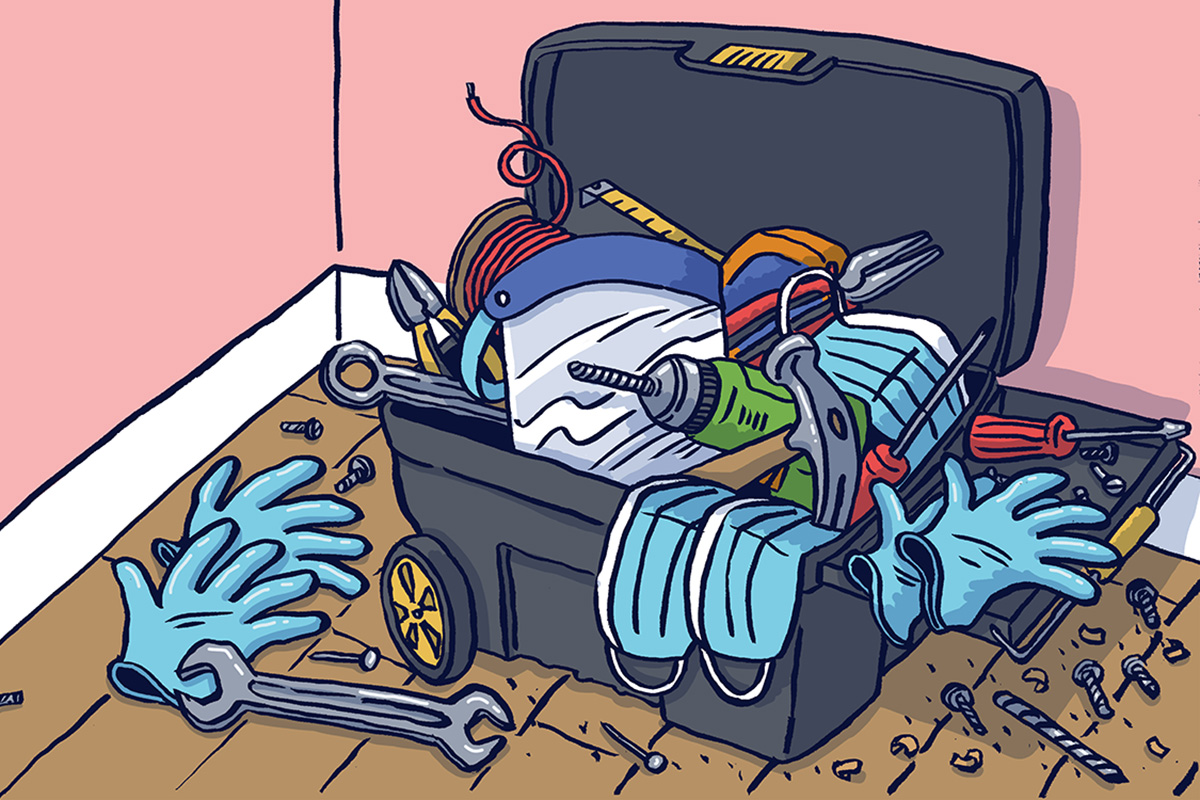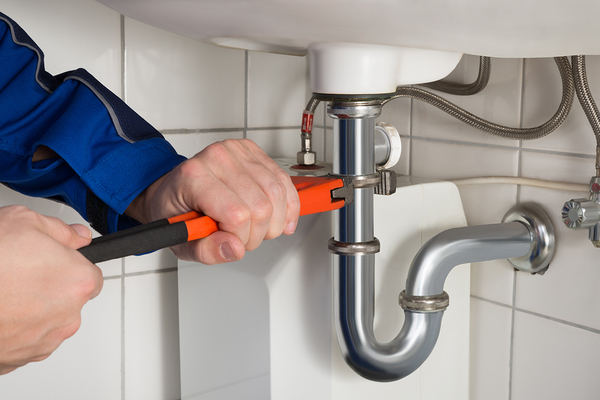You are viewing 1 of your 1 free articles
Repairing the COVID-19 backlog: how repairs services are beginning again post-lockdown
Repairs jobs were the aspect of housing businesses most severely affected by the coronavirus lockdown. Dominic Brady finds out how housing associations are tackling the backlog and what problems they are still facing. Illustration by Dom McKenzie
When the coronavirus lockdown brought the country to a standstill, it was immediately obvious that one area of the housing sector would be affected above all others: repairs.
How do you fix the leaky taps or replace the boilers in 4.5 million social homes when a deadly virus means entering someone’s home carries the risk of infection?
The immediate impact was total upheaval. With all but the most urgent repairs put on hold, entire teams were furloughed, others were shunted into new ad hoc roles and the daily buzz of housing association vans around estates ground to a halt.
As lockdown began to ease in May, social landlords were told to get back out to repair and maintain the homes they own. But it was not a return to normal.
Like everything else, the work would now involve new precautions to limit the spread of coronavirus, as well as tackling the enormous backlog that had built up in the weeks of delay.
So as the new normal beds in, Inside Housing asks how well the new precautions are working and what may still need to change to deliver a safe and efficient repairs service in the era of COVID-19.
Sector sources speak of three key aspects to this: shortages of materials, personal protective equipment (PPE) and planning a way through the mountain of work that has built up.
From toilet paper to hand sanitiser and coronavirus tests, shortages of materials have been a key feature of the pandemic in the UK. For repairs teams, this is not over yet. With manufacturing facilities closing across the country, production of key repairs materials was halted suddenly.
Housing associations, contractors and house builders were forced to compete for increasingly scant levels of materials such as plasterboard and fencing – shortages that are still being felt.
Plasterboard in particular has turned to gold dust in the COVID-19 marketplace, with numerous housing associations highlighting it as an area of concern.
“Getting hold of things like plasterboard has been a real issue,” says Andy Isted, head of business development and strategy at Peabody.
Supply chain problems for plasterboard remain, as Mark Batchelor, director of property services at Hyde, adds: “The main issue we have had and still have is around building materials like plasterboard. There’s still a demand issue.”
Russell Thompson, chair of Direct Works, a representative body for housing associations and local authorities employing their own trade staff, says: “There’s need for it, not just in social housing, but in the wider construction sector – so everyone is pulling on the same stock.”
Mr Thompson notes that shortages in these areas have been seen before, but repairs teams have been caught short as there was no way they could have planned for this most recent shortage.
The days of chronic PPE shortages in the NHS and care homes might seem like a distant memory, with members of the public now being required to wear masks in shops and on public transport. But from a business perspective, the elusive equipment remains an issue.
As Mr Thompson says: “PPE is still a problem. The burn rate is faster than our members expected. It’s not an issue in terms of ordering, but people are trying to build up enough reserves on their shelves.”
Some Direct Works members are struggling in their attempts to build up three to six months’ worth of PPE “just in case we see a second spike”.
He adds: “It’s creating additional cost – nobody has budgeted for the amount of PPE. Going forward, organisations are going to have to build that into their financial plans.”
More and more organisations are moving to reusable PPE because of the costs linked to disposing of single-use equipment in a safe and environmentally friendly way, he says.
Neil Watts, director of service delivery at 60,000-home Peabody, recalls the early days of the pandemic in which the association looked for innovative ways to build up its PPE level.
He says: “We set up a PPE taskforce – a team of negotiators in a way – to get it from wherever we could. We got shields from schools, people got in touch via Facebook, and we tried to get some shipped from China but some items got held up at customs.”
What then of the backlog? Counterintuitively, an unexpected result of scaling back repairs services is improving rates of customer satisfaction for many housing associations.
Mr Watts puts this down to the general trend of increased gratitude to key workers during the pandemic and the type of work being done. Customers are more likely to appreciate emergency works such as fixing a hole in their roof as opposed to sorting a leaky tap.
But maintaining this level of satisfaction will be difficult as Peabody gets non-essential repairs back online. The association’s demand for repairs has almost fully recovered, falling from 16,000 repairs requests in January to just under 5,000 in April before returning to around 12,500 today.
“We now have an action plan to get 85% of our open orders done within a 30-day period. That’s our target to get the backlog smoothed out,” says Mr Watts.
Newcastle-based Karbon Homes took action quickly in order to buy time to work through repairs.
“We had a period where we didn’t take any new cases for three weeks,” explains Ian Johnson, director of property services at Karbon Homes.
Taking these steps allowed operatives more time to comply with new measures such as thorough cleaning of surfaces.
“As for the backlog, at one point we had 2,000 jobs logged in the system and we have now got that down to about 100,” Mr Johnson says.
However, working through the backlog is just the first step with the potential of local lockdowns on the horizon, such as the ones seen in Leicester, Greater Manchester and Aberdeen.
Mr Watts says that Peabody is now actively drawing up contingency plans for more local lockdowns and looking at how it can continue to provide a repairs service. The landlord is preparing for lockdowns of all sizes whether it be in a borough, estate or individual care home and considering how that will affect their operations.
Elly Hoult, group director of assets at Notting Hill Genesis (NHG), says the association has planned as much as it can for a local lockdown scenario and suggests that its experience during the initial lockdown stands the landlord in good stead.
“The infrastructure is there to switch things on and off,” she adds.
On top of this, concerns remain around the extent to which tenants have not been reporting repairs works in order to avoid coming into contact with operatives.
With the government drumming into its citizens the idea that all unnecessary contact should be avoided, it is easy to imagine huge amounts of minor repairs going unreported.
Karbon Homes’ timeline for reviving its repairs service
18 May to 1 June
Complete all existing external logged repair jobs including bricklaying, roofing and subcontractors.
1 June
Phone lines open for new external repairs, eg bricklaying, roofing and subcontractors.
15 June to 6 July
Contact customers and try to reorganise existing internal logged repair jobs such as joinery, plumbing, plastering and electrical.
6 July
Phone lines open for internal repairs such as joinery, plumbing, plastering and electrical.
This “latent backlog” – as Greg Campbell, a partner at consultancy Campbell Tickell, describes it – has the potential to be a blow to repairs services in the months to come, especially as tenants become more comfortable having people in their home.
So what about the prospect of a repairs frenzy when restrictions are lifted further? Repairs teams need to start planning for this eventually, according to Mr Isted.
“At the moment, customer confidence is increasing, but we are in holiday season where repairs requests are traditionally low. So we think that September, October and into winter is going to be busier than normal,” he explains.
All of this change may drive a wider transformation of repairs services. Necessity, it is said, is the mother of invention and many housing associations view the coronavirus pandemic as the catalyst that started to push through some long-standing objectives around transformation.
Mr Campbell explains: “There’s a wider process that’s been going on for a while and I think the pandemic has encouraged people to look at these sorts of options as part of their longer-term strategies.”
Ms Hoult says NHG has been making much more use of video to get services back up and running.
“We were able to do some voids by allowing surveyors to go and video the property, assess it and then instruct what work needs doing,” she explains.
Peabody took a similar approach by using videos in its voids process and sharing videos of vacant properties to customers before organising a full viewing.
“Our modernisation programme was always on that route but it [the pandemic] has just fast tracked it,” Mr Watts concludes.
But the shift to technology-focused solutions is not without its drawbacks. As Mr Thompson says, the change has exposed a skills gap within workforces.
“If you are a manager who is used to overseeing 20 tradespeople and allocating them jobs face to face every morning, my gut feeling is that they are not managing as well as they were,” he suggests.
New methods of working have no doubt driven efficiency in some areas but Mr Thompson warns of a “definite skills gap” for some staff.
These are among the challenges which social landlords must overcome to keep the lights on and the leaky taps fixed in the era of COVID-19. It is likely the transformation that this entails is only just beginning.













